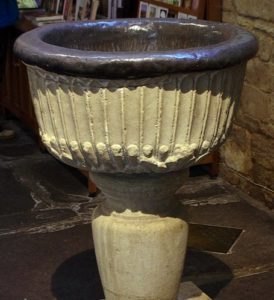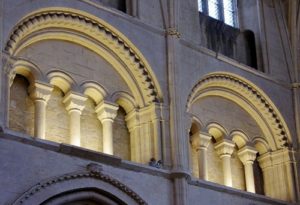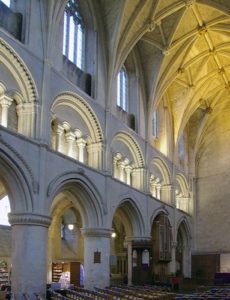Malmesbury was founded as a Benedictine monastery around 676 by Aldhelm, nephew of king Ine of Wessex. King Æthelstan died in Gloucester in 939 and was buried in Malmesbury Abbey in 941. By the 11thC it housed the second largest library in Europe and was one of Europe’s leading seats of learning.
The building was substantially finished by 1180. The central tower and spire collapsed during a storm in 1500 destroying much of church. Then the west tower fell down in 1550, demolishing the end bit of the nave.
The Abbey closed in 1539 at the Dissolution of the Monasteries and was sold to a rich merchant, William Stumpe. He gave the remains of the abbey church to the town as a parish church. He then filled the rest of the buildings with looms for his cloth weaving business.
Only the nave and aisles remain of the Norman abbey. There is little left of the other buildings. The cloisters is a pleasant grassy area.
There may not be much left, but what there is is splendid. It is worth walking round the outside of the building to admire the craftsmanship. Only one of the west towers survives, giving the abbey a lop sided appearance. This is covered with blind Norman arcades with chevrons and billet heads. There is an open carved balustrade along the top of the clerestoried nave and side aisles. Flying buttresses with tall pinnacles swoop from the side aisles to the nave.
The south porch is huge and has the most magnificent doorway with eight rows of carvings of Biblical scenes set inside a plain arch. Inside there is a vaulted ceiling and stone benches along the walls with blind arcades with chevrons above. Above them, set in a semi-circle on either side are the twelve apostles with a horizontal figure above – the Holy Spirit maybe?
The south door itself is equally impressive with three bands of decorative carving around the tympanum with Christ in Majesty with an angel on either side.
The original wooden doors are still there, but no longer used. Instead they are replaced by automatic glass doors.
The inside is equally impressive and has the WOW factor, even though it does end rather abruptly in a blank stone wall at the east end. The end of the church was never rebuilt after the central tower fell down.
Light floods in through the clear glass windows. Combined with the very pale stone this makes the inside very light. It almost shines in the light.
Massive round pillars with carved capitals support slightly pointed arches. Above the top of the arches is a narrow band of round billets with carved heads at the top and ends. Above them is a blind arcade with round arches with chevron carving which enclose three smaller pillars with round arches. The tall windows in the clerestory are later Decorated style and have pointed arches above leading to the vaulted ceiling with carved bosses.
On the south wall of the nave is what could be described as a ‘signal box’ . There seems to be mixed opinions about its function. It has been suggested that it was an observation post as the nave would have been full of relics. Another suggestion is that the first organ may have been placed here.
There is no separation of nave and chancel. There are choir stalls in the chancel and an altar rail with barley corn twist pillars across the sanctuary. There is panelling across the end of the chancel with a stone reredos with IHS carved in the centre. Chancel bosses have been repainted and regilded and look splendid. They are a mixture of human heads and abstract designs.
At the end of the south aisle are glass cases containing copies of hand written illustrated Bibles.
At the end of the north aisle is the 14thC memorial tomb of King Æthelstan who was buried near here. His effigy has a small crown and long flowing robes. His feet rest on a lion. Above is a fan vaulted canopy with crocketed spires above.
On the north wall is a small treasury of church silver.
At the back of the north aisle is a small shop selling books, cards etc and cafe open from 9.30-3.30 selling homemade soups, paninis and cakes.
Malmesbury Abbey gets 4* in Jenkin’s “England’s thousand Best Churches”. We’d give it 5*. There may not be much of the original abbey left, but what there is is magnificent. The south doorway has been described as having some of the best Romanesque sculpture in the country. The inside is pretty impressive too.
The church is open 9-5 daily (4 in winter). Entry is free, although a donation of £3 per person is suggested. There is some parking, including disabled parking, on the street outside. The church is fully accessible to disabled visitors and the welcoming stewards are friendly and knowledgeable. This is definitely worth visiting.










